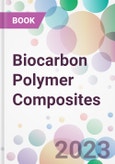Readers will gain a comprehensive understanding of the science and technology behind biocarbon polymer composites, enabling them to make informed decisions in materials selection and development. In an era of increasing environmental consciousness, this book emphasizes the eco-friendly nature of biocarbon composites, offering sustainable alternatives to traditional plastics. Additionally, this book bridges the information gaps between different disciplines and it is intended for a wide range of readers, from materials scientists and engineers to environmentalists and industry policymakers.
Readership:
Researchers and scientists in materials science and engineering; Professionals in industries seeking sustainable alternatives to traditional plastics; Environmentalists and policymakers interested in promoting eco-friendly materials; Academics and students studying materials science, polymer chemistry, and sustainable technologies; Innovators and entrepreneurs looking to capitalize on emerging materials trendsTable of Contents
- Contents
- Preface
- Acknowledgement
- List of Contributors
- Nanocomposite and Its Applications
- Vandana Molahalli, Jasmine Joseph, Kiran Bijapur, Aman Sharma, Gowri
- Soman and Gurumurthy Hegde
2. Biocarbon for Sustainable Environment
3. Biocarbon for Supercapacitors
4. Biocarbon for Medical Applications
5. Thermal Conductivity Study of Biocarbon
6. Biocarbon Nanomaterials in Solar Cells
7. Polymer Nanocomposite
8. Synthesis of Polymer Nanocomposite
8.1. In-Situ Chemical Polymerization
8.2. Solution Method
8.3. Melt Extrusion
8.4. Sol-Gel Method
8.5. Melt Blending
8.6. Hand Layup Method
9. Recent Advancements in the Carbon Based Polymer
- Nanocomposite
10.1. Biocarbon Reinforced Thermoset Polymers
10.2. Epoxy Resin
10.3. Biocarbon-Filled Polyurethane (Pu) and Polyester Resin
10.4. Polylactic Acid (Pla)
11. Conducting Polymers
12. Applications of Biocarbon-Based Polymer Nanocomposite
- Conclusion
- Acknowledgement
- References
- Advances and Perspectives
- Giulio Malucelli
2. Synthesis of Biochar (Bc)
3. Biochar-Thermoplastic Polymer Composites
3.1. Biochar in Polyolefins
3.2. Biochar in Polyamides
3.3. Biochar in Polyesters
3.4. Biochar in Other Thermoplastic Matrices
4. Carbonaceous Fillers Vs. Biochar in the Design of Polymer
- Composites
- Conclusion and Future Perspectives
- Acknowlwdgements
- References
- Radhika Mandala, B. Anjaneya Prasad and Suresh Akella
2. Overview of Carbon
2.1. Sources of Biocarbon
2.2. Synthesis of Animal-Based Biocarbon
3. Polymer Composite Fabrication
4. Thermal and Mechanical Properties of Polymer Composites
4.1. Mechanical Properties
4.2. Thermal Properties
- Conclusion
- References
- Energy Storage With Biochar Polymer Nanocomposites
- Venkateswara Rao Kode
2. Composition
2.1. Almonds
2.2. Walnuts
3. Biochar
3.1. Synthesis
3.2. Pyrolysis
3.3. Gasification
3.4. Hydrothermal Carbonization
4. Biochar-Encapsulated Polymer Nanocomposites:
4.1. Synthesis of Phase Change Materials
4.2. Characterization
5. Thermal Properties
- Conclusion
- References
- Filaments in the Fdm Process - a Short Review
- Singaravel Balasubramaniyan, Niranjan Thiruchinapalli and Rutika Umesh Kankrej
2. Literature Review
3. Discussion
- Conclusion
- References
- Pbat/Pla/Carbonaceous Biocomposites
- Gustavo F. Souza, Rene R. Oliveira, Janetty J.P. Barros, Fernando L. Almeida And
- Esperidiana A.B. Moura
2. Materials and Methods
2.1. Materials
2.2. Rice Husk Ash (Rha) Preparation
2.3. Composite Preparation
2.4. Filament Preparation
2.5. Fdm 3D Printing
2.6. Characterization Methods
2.6.1. Thermogravimetric Analyses (Tga)
2.6.2. Fourier Transform Infrared Spectroscopy (Ftir)
2.6.3. Scanning Electron Microscopy (Sem)
2.6.4. Mechanical Testing
3. Results and Discussion
3.1. Tga
3.2. Ftir Analyses
3.3. Sem Analyses
3.4. Mechanical Tests
- Conclusion
- Funding Sources
- Acknowledgement
- References
- Electrical Conductivity
- Mahesh K. Pallikonda and Joao A. Antonangelo
2. Mechanisms of Electrical Conductivity in Polymer Composites
3. Factors Influencing the Electrical Conductivity in Polymer
- Composites
3.2. Degree of Graphitization
3.3. Precursor Material
3.4. Different Concentrations of Filler Material
- Conclusion
- References
- Composite Films for Packaging Applications
- Gautam Chandrasekhar and Vijaya Rangari
1.1. Overview of Plant-Derived Carbon-Based Materials
1.2. Biochar Carbon-Reinforced Polymer Composites
2. Materials and Methods
2.1. Materials
2.2. Synthesis of Carbon by Pyrolysis
2.3. Characterization of the Synthesized Carbon
2.3.1. X-Ray Diffraction (Xrd)
2.3.2. Raman Spectroscopy
2.3.3. Scanning Electron Microscopy (Sem)
2.4. Blown Film Extrusion
2.5. Analysis of Films
2.5.1. Thermogravimetric Analysis
2.5.2. Differential Scanning Calorimetry
2.5.3. Tensile Test
3. Results
3.1. Scanning Electron Microscopy of Cspc
3.2. X-Ray Diffraction
3.3. Raman Spectroscopy
3.4. Thermogravimetric Analysis
3.5. Differential Scanning Calorimetry
3.6. Tensile Test
3.7. Fracture Surface Analysis of Ldpe/Cspc Films Using Sem
- Conclusion
- Funding Sources
- References
- Filtration
- Sabina Yeasmin and Soma Bose
2. Biochar in Water Treatment
3. Polymer Nanocomposites in Water Filtration
- Conclusion
- References
- Subject Index
Author
- Deepa Kodali
- Vijaya Rangari








